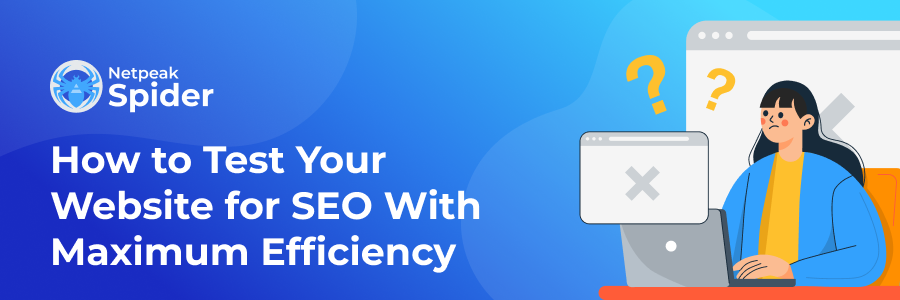How to Perform a Website Quality Test with Netpeak Spider
How to
Content marketing is a powerful tool for business promotion and advertising. For this tool to work effectively, you need to ensure the quality of content, its usability for visitors, and its optimization for search engines. No one wants to lose readers and potential customers, and this post is exactly about how you should test your website SEO and the key aspects you have to optimize in the first place.
What is an SEO test?
An SEO quality website test evaluates how well a page is optimized for search engines like Google. These tests, often run via web or software tools, monitor and analyze various elements of a page to detect areas of improvement and define the page's strongest spots.
The results you receive after you test a website will help you refine your SEO strategy.
Why conduct an SEO assessment test?
An SEO web site test discloses your SEO strategy's key strengths and weaknesses. Without regular site checkups, your SEO campaign won’t be as effective as possible, and you could miss out on valuable site traffic and high-quality leads.
You can significantly benefit from running SEO tests before implementing your optimization campaign to provide a baseline for where you started. For the same reason, checking your SEO beforehand is also essential.
You can only expect a sub-par SEO grade when you run a website quality check and the target site isn’t optimized. However, over time, you’ll be able to compare your enhancing SEO results to the ones you started with, showing you just how your SEO campaign is performing.
It’s also essential to run SEO tests on your website regularly to ensure your SEO campaign is working as planned. Doing so gives you valuable insights into how well your methods work and what areas still need improvement.
How can I check my SEO performance with Netpeak Spider?
Now that you understand the importance of running web site quality tests, let me show you how to do that quickly and easily with Netpeak Spider, a powerful multi-functional website crawling tool.
Content length
The topic you're writing about must be covered as well as possible to ensure the quality and usefulness of the content. But how many words does it need to be for it to rank well in search engines? Many studies show that texts of 2,000 words or more rank higher than content much shorter in length.
- First, the longer the text, the more clues search engines have about it.
- Secondly, it's much easier to organically implement keywords in a large text.
- Thirdly, you can add other keywords to a large text, as you'll likely be able to cover more topics there.
However, this doesn't mean that you should artificially increase the length of your content. Try to cover the topic as voluminously as possible, and if it's not that broad, either choose another topic or expand more on some related questions.
To find out the content volume on your entire site, you can try Netpeak Spider:
- In the sidebar under "Metrics," check these options:
- "Content Size" — the number of characters with spaces;
- "Number of characters" — number of characters without spaces;
- "Number of words".

- Paste the website address into the "Initial URL" box and click "Start." Pages with less than 500 characters will be flagged with a "Min Content Size" error.

You can set your limits in the "Restrictions" settings tab.

You can check the content size and retrieve the data you need even in the free version of Netpeak Spider without time limits, which also offers many other basic features.
To start using Netpeak Spider for free, simply sign up, install the app, and you're good to go! 😉
Structure
Generally, the content structure includes H1-H6 headings, paragraphs, and numbered / bulleted lists. The structure helps make the user experience more convenient, easier to navigate, and overall better.
Also, page structuring is an aspect that is considered when entering the quick reply box.
Here's how you can test a website for content structure with Netpeak Spider:
- Go to the "Content" section of the options in the sidebar and check the required items in the "H1-H6 Headings" subsection.

- Enter the website address and start scanning.
- At the end of the scan, examine the report for these errors:
- Duplicate H1,
- Missing or empty H1,
- Multiple H1,
- Maximum H1 Length.

Fix existing errors and follow these tips when creating content:
- Make unique headings for each article;
- Stick to the correct hierarchy of headings;
- Add keywords;
- Do not use emojis and symbols in your headlines;
- Try to stick to an optimal headline length of 60 characters.
Internal linking
Internal linking is an essential factor for Google and other search engines. It helps to improve navigation for users and search engines and distribute internal link weight. Also, relinking improves promotion: it speeds up site crawling. If a page gets a lot of internal links, it signals to search engine robots that the page is valuable and important for promotion.
Therefore, it's vital to test a website for internal linking and see if no pages aren’t linked to any link. To run the check:
- Check the options in the "Links" section: "Inbound links" and "Internal (outbound) links."
- Start the scan.
- When finished, the results table will have two columns with the names of the selected parameters. See which pages you need to increase the number of inbound or outbound internal links on.
- Also, examine the report for "PageRank: missing links" and "PageRank: missing outbound links" errors.

Display on mobile devices and site loading speeds
Optimizing your blog and content for mobile devices will help you rank better and attract traffic from mobile rendition. Web pages optimized for mobile devices get more reposts on social media.
To optimize pages for mobile devices in Netpeak Spider, scan the website, right-click on the URL of interest in the main table, and select "Open in service" → "Google Mobile Friendly Test."

The service will then open, and the test will begin:

You can also check the page load speed shown in the "Server Response Time" column of the main results table. The program will attribute slow pages to the "Long Server Response Time" error:

Metadata
Meta tags are HTML tags that describe the on-page content to search engines and users, and a website quality check would be insufficient without analyzing them.

Title and description affect website rankings: the more attractive and interesting they are, the more people click the hyperlink and go to the site from the rendition, and Google reads this and raises the site's ranking.
To identify metadata errors, follow these steps:
- In the Netpeak Spider sidebar, check "Title," "Description," "Title length," and "Description length" (Head tags section).
- Run the checkup.

If the app detects problems, the following errors will appear in the report:
- Duplicate Title / Description;
- Missing or empty Title / Description;
- Multiple Title / Description tags;
- Max length Title/Description;
- Short Title / Description;
- Identical Title и H1.
- Emoji and special characters in Title / Description
Here are some tips on creating title and meta description tags:
- Briefly summarize the topic of the main content.
- Stick to the optimal length of the title, which should be within 70 characters, and the description should be from 150 to 170 characters.
- Add keywords.
- Make the title and description different.
- Each page should have unique metadata.
6. Page URLs
Users perceive a readable and understandable URL better. Moreover, URLs are among the key ranking factors.
Here's how you can test web site URLs for errors:
- Check the "Server Response Code" option in the sidebar.
- Start scanning.
- Find out more in the error report.
Netpeak Spider detects the following errors in URLs:
- URLs with incorrect hyphen usage;
- Encoded URLs;
- URLs with irrelevant special characters;
- URLs with capitalized letters;
- Indexed URLs with GET parameters;
- Maximum URL length

Here's how you can optimize your website's URLs:
- Make them simple, clear, and short.
- Use only Latin letters and Arabic numerals.
- Add keywords in URLs.
- Use hyphens instead of underscores.
- Avoid special characters.
Images
Testing a website should also include image optimization. When applied correctly, it can help readers better understand an article. But it's important to optimize them as well and not just add them to your site. Optimizing images affects their ranking in image rendition as well as their ranking.
Netpeak Spider helps you detect image errors such as:
- Broken images;
- Images without an alt attribute;
- Maximum image size (by default - 100 kBytes, but the value can be changed independently in the program settings).
Before scanning, check the "Content Length," "Server Response Code," and "Images" parameters.

Tips for optimizing images:
- Add alt tags and implement keywords there;
- Create an image map;
- Compress images so they don't slow down page loading;
- Mind the quality;
- Spell out the file name.
Check URLs for SEO parameters with Netpeak Checker
As we've established earlier, testing a website is essential to ensure its high performance and make sure everything works perfectly. One of the tools that can help you out is Netpeak Checker.
This powerful tool offers dozens of features and enables extra integrations with various SEO-related services. Here's a brief recap of what else you can do with Netpeak Checker:
Integration with 25 other services to analyze 450+ parameters

Netpeak Checker enables integrations with 25+ SEO services: Moz, SimilarWeb, Ahrefs, Serpstat, Google Analytics, and many more.
50+ on-page parameters

Netpeak Checker delivers research results in a real-time dashboard. The metrics you can monitor include redirects, response time, status codes, title, mobile-friendliness, etc. All you have to do is choose the required stats and hit "Start."
Website traffic estimation

Netpeak Checker shows the traffic volumes on a target page, potential link-building donors’ share ratios, as well as traffic by location. Plus, it shows the types of traffic prevailing on a selected page (e.g., search, organic, direct, mail, social, etc.).
Batch Core Web Vitals checkup

You can retrieve data from Google PageSpeed Insights to monitor your website's load speed, responsiveness, and visual stability.
Integration with Google Drive & Sheets

Connect your Google Drive account to our app to promptly export any report to Google Sheets and easily share them anytime.
Bottom line
To promote content, experts need to work not only on content but also test the overall website quality to ensure its performance is as high as possible. The main aspects of content optimization are:
- Content structuring,
- Internal linking,
- Optimization for mobile devices,
- Reducing the loading speed of the site,
- Metadata optimization,
- Optimization of page URLs,
- Image optimization.
How do you check website quality? Share your tips in the comments. 😊



